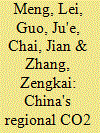|
|
|
Sort Order |
|
|
|
Items / Page
|
|
|
|
|
|
|
| Srl | Item |
| 1 |
ID:
109643


|
|
|
|
|
| Publication |
2011.
|
| Summary/Abstract |
This paper analyzes the characteristics of China's regional CO2 emissions and effects of economic growth and energy intensity using panel data from 1997 to 2009. The results show that there are remarkable regional disparities among eastern, central and western areas, regional elasticities of per capita GDP and energy intensity on CO2 emissions, which reflect the regional differences in economic development, economy structure and restraining function of energy intensity decrease on the emission. Energy intensity reducing is more effective to emission abatement for provinces with higher elasticity of energy intensity, but may not be significant for provinces with lower elasticity. The inverse distribution of energy production and consumption, regional unfairness caused by institutional factors like energy price and tax system result in inter-regional CO2 emission transfer embodied in the power transmission. The calculation indicates that the embodied emission transfer was gradually significant after 2003, from eastern area to the central and western areas, especially energy production provinces in central area, which leads to distortion on the emission and emission intensity. The regional emission reduction targets and supporting policies should be customized and consistent with the actual situations rather than setting the same target for all the provinces.
|
|
|
|
|
|
|
|
|
|
|
|
|
|
|
|
| 2 |
ID:
110741


|
|
|
|
|
| Publication |
2011.
|
| Summary/Abstract |
As the uncertainty of oil price increases, impacts of the influential factors on oil price vary over time. It is of great importance to explore the core factors and its time-varying influence on oil price. In view of this, based on the PATH-ANALYSIS model, this paper obtains the core factors, builds an oil price system VAR model, which uses demand, supply, price, and inventory as endogenous variables, and China's net imports as well as dollar index as exogenous variables. Then we set up a BVAR-TVP (Time varying parameter) model to analyze dynamic impacts of core factors on oil price. The results show that: (1) oil prices became more sensitive to oil supply changes, and the influence delays became shorter; (2) the impact of oil inventories on oil prices with a time lag of two quarters but has a downward trend; (3) the impact of oil consumption on oil prices with a time lag of two quarters, and this effect is increasingly greater; (4) the US dollar index is always the important factor of oil price and its control power increases gradually, and the financial crisis (occurred in 2008) further strengthens the influence of US dollar.
|
|
|
|
|
|
|
|
|
|
|
|
|
|
|
|
| 3 |
ID:
166952


|
|
|
|
|
| Summary/Abstract |
The rise of the shale gas industry and the need for clean, low-carbon energy transformation in China has meant that the relationship between domestic and foreign natural gas markets has become closer. Therefore, identifying the changing relationships between the major global natural gas markets and China's natural gas market has important practical value for the current Chinese domestic natural gas pricing system. This paper used the DCC-GARCH-NARDL-ARDL-ECM as the analytical framework to study these relationships, from which it was found that there was no unified global natural gas market and that China's natural gas market was not yet aligned with this market. It was shown that there was no significant asymmetry in the impact of international gas prices on China's gas prices as no flexible adjustment measures were found in China's imported natural gas pricing mechanism. Moreover, while international natural gas prices were found to have a significant impact on China's natural gas prices over the long term, there were obvious regional differences over the short term. Accordingly, new pricing policies should be designed to promote market-oriented natural gas pricing reforms in acknowledging features such as asymmetry, the difference between imported gas sources and the periodicity of price adjustment.
|
|
|
|
|
|
|
|
|
|
|
|
|
|
|
|
| 4 |
ID:
191201


|
|
|
|
|
| Summary/Abstract |
The new energy demonstration city (NEDC) are conducive to developing and applying renewable energy, reducing carbon emissions effectively, and reshaping the urban economic development model. Therefore, evaluating the impact of NEDC on carbon emission efficiency is of great significance to this policy's development and improvement. This study selected 278 cities in China from 2003 to 2017 to explore the influence and the response mechanism of NEDC on carbon emission efficiency through the spatial difference-in-difference model (SDID). The result shows that NEDC not only significantly promotes the local carbon emission efficiency but also improves the carbon emission efficiency of the surrounding cities within 1000 km. Meanwhile, it promotes urban carbon emission efficiency through optimizing industrial structure, stimulating green technology innovation, and reducing energy intensity, among which the impact of green technology innovation was the strongest. Furthermore, the direct effect of NEDC on carbon emission efficiency is more significant in western, non-resource-based, non-industrial, and large cities in China. The radiation effect of NEDC has already appeared in eastern China, but the spatial spillover effect in large cities has not yet occurred. These findings will help further promote NEDC and provide important decision-making references for urban energy conservation and emission reduction.
|
|
|
|
|
|
|
|
|
|
|
|
|
|
|
|
| 5 |
ID:
180124


|
|
|
|
|
| Summary/Abstract |
Under the double-track price system, alternative energy prices and the spread between liquefied natural gas and pipeline natural gas have created a supply-demand imbalance in China's natural gas market, which poses potential risks to economic development and industrial safety. Based on alternative energy prices, economic development level, and geopolitics, this paper used NARDL (Nonlinear Autoregressive Distributed Lag Model, NARDL) to analyze the effect of the spread on the imbalance in the natural gas market. It was shown that the spread and economic development level had a significant impact on the imbalance. Oil prices and geopolitics didn't have a significant impact in the short term while rising coal prices could alleviate the imbalance. Also, the imbalance and the spread in the natural gas market were likely to form a vicious cycle of mutual increase in the short term. Moreover, the impulse response results showed that the impact intensity of the spread on the natural gas market was greater under the background of “short supply” in 2017. Accordingly, a new pricing policy should be aimed at promoting the market-oriented reform, establishing an asymmetric price adjustment mechanism, and guiding rational consumption.
|
|
|
|
|
|
|
|
|
|
|
|
|
|
|
|
| 6 |
ID:
092853


|
|
|
|
|
| Publication |
2009.
|
| Summary/Abstract |
Energy intensity reflects energy usage efficiency of an economy, in the process of production and consuming of economic output. Why does energy intensity fluctuate in China? In this paper, we explores the distortion of different energy prices, the change of energy structure, technological and final demand structure and their impact on energy intensity in China, based on the path analysis method and input-output structure decomposition model, respectively. And three results have been showed in this paper: first, proved that optimize the relative prices of different types of energy is the most important pricing mechanism when cut down the energy intensity; second, showed that the proportion of oil consumption is the limiting factor that has led to energy intensity change; third, built an input-output structure decomposition analysis model and analyzed technological changes, final demand structure changes, and their direct and indirect impact on energy intensity based on energy input-occupancy-output tables of 30 industry sectors of China in 1992, 1997, 2002 and 2004, which suggest that the fluctuation of energy intensity is mainly due to technology advances and the corresponding change in industrial structure.
|
|
|
|
|
|
|
|
|
|
|
|
|
|
|
|
|
|
|
|
|